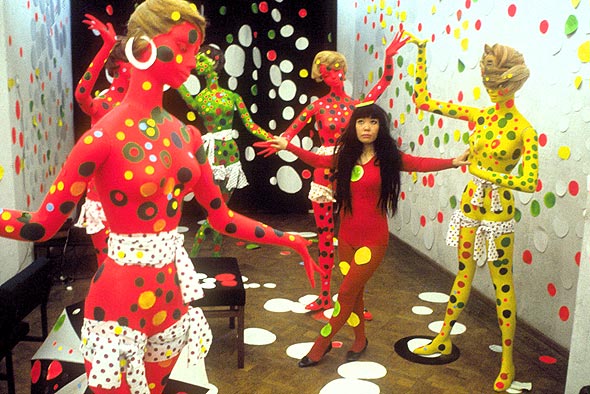
 A documentary illuminates the life, and especially the bold work, of the groundbreaking Japanese artist Yayoi Kusama.
A documentary illuminates the life, and especially the bold work, of the groundbreaking Japanese artist Yayoi Kusama.
Japanese artist Yayoi Kusama is one of the foremost innovators in modern painting and design. One of her work’s most characteristic elements, although by no means her only one, is the dot. Colorful dots fill her canvases and exhibitions, in such profusion that they look like the star-filled universe, or in other words, infinity. In fact, she calls these huge fields of polka dots “infinity nets,” and they are based on visions she had experienced in nature since childhood. This provides the title for a new documentary about her life and work—Kusama: Infinity.
What approach should a director take in making a film about an artist? The answer from Heather Lenz, the director of Kusama: Infinity, includes plenty of interview material, from Kusama herself, friends, fellow artists, critics and art dealers. It also includes lots of footage and stills from her long life, especially from her crucial and controversial work in New York in the 1960s and early 70s. But more than anything else, Lenz just shows us the work—the camera carefully and lovingly examining her paintings, soft sculptures and exhibitions. There’s nothing unusual about this approach, even though Kusama’s art is itself wild and unusual—this is just the way a film about art should be. When the audience gets to see the art, and the art is the main focus of the film, then we can accept the artist’s vision and her greatness. And few will be able to resist the power of these images.
The life story that emerges is quite moving, and in some ways almost tragic. Kusama’s family discouraged her from painting. They did not believe that a girl should try to be an artist. She was meant to be a wife and have children. Kusama had some modest success showing watercolors in Japan. She wrote to Georgia O’Keeffe, after seeing one of the American painter’s works, and received encouragement from her. At the age of 28, feeling stifled by the indifference of the Japanese art world, she moved to Seattle, and then to New York, barely getting by in Greenwich Village, before gaining some attention in the world of avant-garde painting in the 60s.
The film reveals a disturbing pattern that highlights the second-class position of women, and especially women of color, in the art world. Kusama would come up with an innovative concept in one of her shows—such as using mirrors and mirror balls to multiply the visual effects of the paintings in a room, creating a brilliant house of mirrors look. Other more well-known artists, white men, including in one instance Andy Warhol, would see her work, and then adopt her ideas in their own shows, which would become famous while her art was neglected.
During the years of the Vietnam protests, and as part of her quest to become more visible, Kusama staged antiwar events or happenings where she would paint people’s nude bodies in public. She did get attention this way, but she also made enemies. A suicide attempt and a decline in health led to her leaving the U.S. and going back to Japan in ’72. A long period of obscurity followed, another suicide attempt, and she ended up in a psychiatric hospital. There, without the pressure of having to be a success in the world, she began a new, even more vibrant phase in her work.
I used the phrase “almost tragic” before, because as the final third of the film demonstrates, her recognition as a world-class artist finally started to happen in the 1980s, growing more and more over the years until today, when at the age of 89, this diminutive woman with her brightly colored hair and clothes, has become the embodiment of her own unique vision.
Heather Lenz shows a lot of integrity in the film by not overemphasizing the dramatic arc of Yayoi Kusama’s life—we learn her story, but the most important story is the art itself, which we get to see in abundance. Kusama: Infinity does its job well, inviting us to witness the creation of ineffable beauty.

